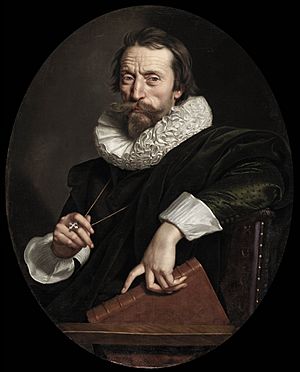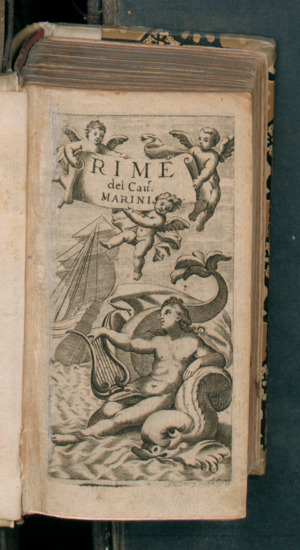Giambattista Marino facts for kids
Quick facts for kids
Giambattista Marino
|
|
|---|---|

Portrait of Giovanni Battista Marino, c. 1621. Oil on canvas, 81.0 x 65.7 cm. Detroit, Detroit Institute of Arts
|
|
| Born | October 14, 1569 Naples, Kingdom of Naples |
| Died | March 26, 1625 (aged 55) Naples, Kingdom of Naples |
| Occupation | Poet |
| Language | Italian |
| Nationality | Napoletano |
| Period | from 1602 |
| Literary movement | Baroque, Marinism |
| Notable works | La Lira L'Adone |
Giambattista Marino (also known as Giovan Battista Marini) was an Italian poet born in Naples on October 14, 1569. He is most famous for his long poem, L'Adone. Many people at the time thought he was one of the greatest Italian poets ever.
Marino started a new style of poetry called Marinism. This style was known for using very fancy and sometimes over-the-top comparisons and wordplay. His poems often had beautiful descriptions and a musical sound. This style was very popular during his time, much like Petrarch's poetry was before him. Poets in Italy, France, Spain, and other countries copied his style. Even famous English poets like John Milton admired his work.
Contents
Giambattista Marino's Life
Marino lived in his hometown of Naples until the year 1600. He enjoyed life and didn't follow his father's wish for him to become a lawyer. These early years in Naples were very important for how his poetry developed. Even though he spent most of his career in northern Italy and France, Naples shaped his writing.
His father was a well-educated lawyer who knew many important people, including Giambattista Della Porta, a natural philosopher. Marino learned a lot from these thinkers, which influenced his poetry. He also knew Torquato Tasso, another famous poet.
Marino later moved to Rome and then to Turin in 1608, where he worked for Duke Carlo Emanuele I. In 1615, he moved to Paris, France. He stayed there until 1623 and was highly respected by the French court and writers. He returned to Italy as a celebrated poet and passed away in Naples in 1625.
Giambattista Marino's Works
Marino wrote a lot of poetry and prose (regular writing). His poems are the most famous and were copied by many others.
His Poetry
Le Rime (1602) and La Lira (1614)
Marino created a new, "soft, graceful, and attractive" way of writing poetry. He moved away from older styles and strict rules. You can see this new style in his collection of poems called Le Rime from 1602. This collection was later made bigger and renamed La lira (meaning The Lyre) in 1614.
His poems often looked back to old Greek and Latin writings, especially the love poems of Ovid. He also used ideas from an old Italian poetry style called Dolce stil nuovo.
In 1620, Marino published La Sampogna. This was a collection of poems split into two parts: one with poems about country life and shepherds (called pastoral idylls) and another with "rustic" (countryside) poems. This showed he was exploring new topics beyond just love or heroic stories.
L'Adone (Adonis)
L'Adone (meaning Adonis), published in Paris in 1623, is a long poem about myths. It's written in a special eight-line stanza called ottava rima and has twenty parts, or cantos. Marino dedicated this poem to the French king, Louis XIII.
The Story of L'Adone
The poem tells the story of the goddess Venus and her love for Prince Adonis. Adonis escapes a sea storm and finds safety on the island of Cyprus, where Venus lives. Cupid, Venus's son, uses his magic arrows to make his mother and Adonis fall in love.
Adonis listens to Cupid and Mercury tell love stories. Then, he visits the Garden of Pleasure, which has five parts, one for each of the senses. He also sees the fountain of Apollo.
However, Mars, who is also in love with Venus, gets jealous. He finds out about Venus and Adonis and heads to Cyprus. When Adonis learns Mars is coming, he runs away. He is then turned into a parrot because he refused Venus's love.
With Mercury's help, Adonis becomes human again. He is captured by robbers but eventually returns to Cyprus. There, he wins a beauty contest, becomes the ruler of the island, and is reunited with Venus. But Mars causes Adonis to be killed by a wild boar during a hunting trip. Adonis dies in Venus's arms, and his heart turns into a red flower called the anemone. The poem ends with a long description of the games held to honor the dead Adonis.
How the Story is Told
Marino filled L'Adone with many famous stories from myths, like the Judgement of Paris, Cupid and Psyche, and Echo and Narcissus. The poem was originally planned to be only three cantos long, but Marino added so many stories that it became one of the longest poems in Italian literature. It has 5,123 eight-line stanzas, which means 40,984 lines! It's a huge story with many side tales and detailed descriptions.
This makes L'Adone feel like a maze of connected stories without a simple, clear structure. The very long last canto, which happens after Adonis dies, shows that the poem doesn't have one main plot. But this lack of a single plot was actually Marino's new way of telling a story. He moved from one event to another without a clear logical order, connecting them instead with language full of strong comparisons, opposites, and metaphors.
In Adone, Marino also used and rewrote parts from older famous works like Dante's Divine Comedy and poems by Ariosto and Tasso. He wasn't trying to copy them. Instead, he wanted to create a fun game for the reader, who could spot where he got his ideas from and enjoy how he changed them. Marino believed that everything in the world, including past literature, could become part of new poetry. In this way, Adone became like a poetic encyclopedia, collecting and updating all the great ideas from human history.
The poem also shows a new way of thinking, connected to the latest scientific discoveries (like his praise for Galileo) and new places found around the world (like his description of the passiflora flower from the Americas). Even with all its clever tricks, Adone is a work full of true poetry, written in a style that often has perfect rhythm.
Other Poems
Marino wrote other poems too, such as I panegirici (poems of praise) and La galleria (descriptions of paintings and sculptures). He also wrote a religious poem called La strage degli innocenti (The Massacre of the Innocents), which was published after he died. He wrote some funny poems too, like La Murtoleide, which had 81 satirical poems against another writer.
His Prose Works
His most important prose work is Dicerie sacre (1614). This was a guide for priests on how to give speeches. It was very popular for many years. In these very long speeches, Marino used his style of continuous metaphors to an extreme. His "Letters" are also interesting for readers today. They show his artistic and personal experiences. In these letters, Marino defended his poetry, saying he was just writing what the powerful people of his time wanted to read.
Giambattista Marino's Influence
Marino was very famous in his time. People saw him as the person who updated and continued the work of Tasso. His influence on Italian and other literature in the 1600s was huge. He was part of a big movement across Europe that included similar styles in France, England, and Spain.
Music
Marino's poems were very popular with composers of his time. Claudio Monteverdi, a famous composer, used several of Marino's poems in his collections of madrigals (songs for several voices). In 1626, Domenico Mazzocchi used Marino's epic poem for his opera La catena d'Adone (The Chain of Adonis).
Later Literature
Marino is the subject of a short story called "Una rosa amarilla" ("A Yellow Rose") by the famous writer Jorge Luis Borges. This story appeared in Borges's collection El hacedor in 1960.



